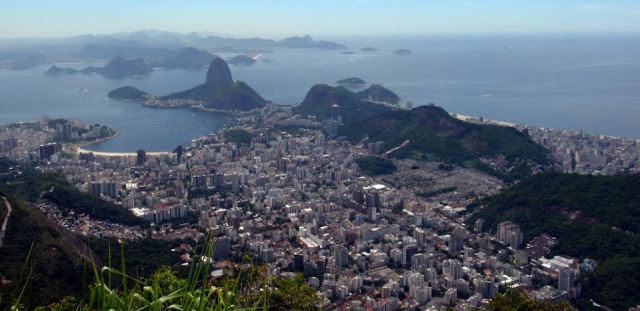
Looking down across Rio
The six million inhabitants of Rio were joined by another 750,000 tourists, all in town for the carnival. As a result everywhere was exceptionally crowded, which made it all the more amazing that we loved everything we visited. The first day we took the tram up the Corcovado Mountain to the statue of Christ the Redeemer. At 33m high this stands looking over the entire region, facing towards the Sugar Loaf Mountain, and provides an excellent way to get your bearing with an overview of the city layout.
That evening we took the packed metro to the Maracana, previously the world’s largest stadium, capable of holding over 200,000 people, but now reduced to 89,000 fervent supporters. We were there to watch a league semi-final Rio derby between Vasco and Fluminense. The game was hard fought and the fans supported with huge flags and firework displays, but still ended scoreless and went to a tense penalty shootout, with Vasco triumphing 6-5.
The next day was a relaxed one in preparation for the evenings 13 hour party at the Sambadrome, watching a parade of floats and dancers compete for the honour of being voted best Samba school of the carnival. We didn’t get great seats, but the music and spectacle got us through until the early hours, and a very quiet group didn’t appear until late afternoon the next day.
8 of us decided on a community organised Favela tour. The favelas are the slums built onto the hills of Rio, often unpoliced and therefore a haven for criminals. Many of the tours are terribly intrusive, invading houses and peoples privacy, one even travels round in a safari truck, with tourists spotting poor people from the safety of their elevated glass box. Our tour was to the Morrinho Project, which has grown out of a group of children creating a model of the favela and using it as a set for short films. I’d really recommend their web site to view some of the films – they’ve won awards at the Latin Film Festival and Sundance: http://www.morrinho.com
The following morning we split up and made our way to the Pão de Açúcar, or Sugarloaf Mountain. Nearly 400m high it’s reached by two cable cars, the first stopping at the Urca peak, then another at 90 degrees up to the Sugarloaf. To be honest ,given the carnival crowds and extreme heat I was a bit underwhelmed. It is just another view of the city from the other end from the Corcovado, with the huge statue of Christ to be impressed by. We visited the top and after 20 minutes of wandering about went down to the much more pleasant and shady Urca peak and waited in one of the many fruit juice bars.
That afternoon we hit the Copacabana and Ipanema beaches in 41 degree heat. All the guide books recommend Ipanema, but we unanimously agreed that Copacabana was the better beach, with nicer sand, friendlier people and better facilities.
The next day was entirely free so after a morning wandering round the colonial remnants of Rio’s Centro district we boarded the ferry to Niteroi, the second largest district of Rio, across the water. The ferry was cheap and quick and deposited us in the town centre. Having left in a bit late we missed the sunset but there was just enough light to get the reason for coming – it’s the only place in Rio from where you can see both the Corcovado and Sugar Loaf mountain. Photo taken, we headed to a shopping mall and tried a new Arabic fast food chain called Habib’s, hoping to take the world by storm. The photos on the menu were considerably more appealing than the food itself and somewhat disappointed we crossed back over the river to the hotel.
This was the end of the Rio leg of the tour and as is usual we had to say goodbye to a number of new old friends. Some were harder than others to say goodbye but on the final day we declined a large group meal in favour of 5 of us travelling to Ipanema for a Mexican meal, but ended up in the wrong street and enjoyed Thai food instead. I’m glad I experienced the mess that was carnival, but I’d love to visit Rio again when it’s not so frantic.






Greece’s 4th biggest city has just launched a planet-wide internet channel to show off the biggest event of the year – a first for any city in the world!
The Patras Carnival is the largest such event in Greece and one of the biggest carnivals in Europe with more than 160 years of history.
Our carnival is not a single event but a variety of events that includes balls, parades, treasure hunt game, kids’ carnival and more.
The high point is the last weekend (5th and 6th of March) with the Saturday evening parade of carnival groups, the extravagant Sunday parade of floats and groups, and finally the ritual burning of King Carnival at the St. Nikolaos Street wharf in the harbour of Patras.
This year an enlightened organization committee the PCPWME * are pleased to announce a WORLD WIDE FIRST – an initiative that will allow anyone with access to the internet across our whole planet to watch and join in the festivities.
The Patras Carnival web channel is already broadcasting extracts of older and more recent Carnival events.
Friends of the carnival will be informed about the activities of the carnival from the Carnival Press news channels on the site, culminating in three internet LIVE broadcasted carnival events:
Don’t miss!!!
Pingback: My A to Z of Travel | You're Not From Around Here, Are You?